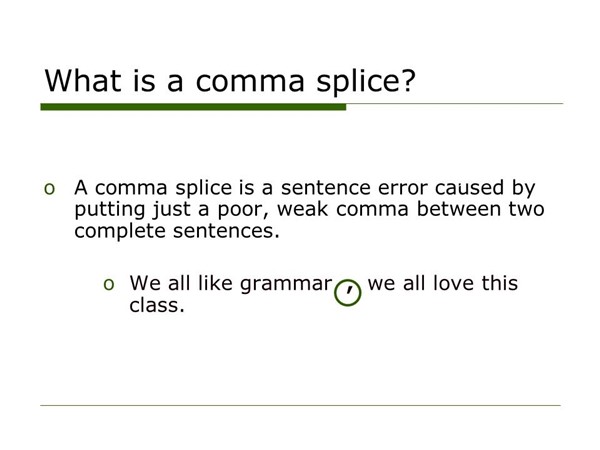When does comma splicing occur?
In order to fix instances in which a comma splice has been misused, we must first make sure the writer has in fact deployed an erroneous comma splice, and is not simply using the comma as it is meant to be used. Since the comma is one of the most prolific and useful punctuation tools, there are many grammatical scenarios in which it is properly used as a means of extending a train of thought while avoiding a run on sentence.
So it’s important to make sure that we accurately call out the comma splice. One effective way to do this would be to examine the below examples of comma splices. .
I get distracted easily when I work from home, sometimes I am more productive.
The grocery store appears to be out of hand soap, they’re also out of canned vegetables.
As you can see in the sentences above, on either side of the comma there is a group of words called an independent clause which, in the absence of the comma, could actually stand alone as a complete sentence. The front portion of the sentence is clearly related to the latter portion, given that they both refer to the circumstances around working from home in the first instance, and grocery store stock outs in the second. However, as we are learning, it is incorrect to fuse the two clauses together with a “comma splice” and express the two sentiments as two parts of the same sentence.
How do we fix sentences with a comma splice?
This of course begs the question – what IS the proper way to express two related thoughts without unnecessarily making a grammatical error? There are actually a few options that would correctly accomplish what the comma splice attempts. Let’s explore those below.
Use a semi-colon
The first weapon in your grammatical arsenal is the powerful and yet oft misunderstood semi-colon. It’s a shame the semi- colon doesn’t get nearly as much notoriety as the comma, especially since there are so many occasions where it ought to be used in place of the comma! Let us revisit one of the sentences used as an example above in order to illustrate this point:
I get distracted easily when I work from home; sometimes I am more productive.
As you can see, the solution is quite simple. We have replaced the offending punctuation mark ( the comma) with a semi-colon and fixed the problem without having to make any changes to the actual content of the sentence. The text flows the same, you avoid a run-on sentence, and most importantly, you have not committed any offenses to English grammar.
Let’s see how this solution applies to another sentence – the second of our original examples.
The grocery store appears to be out of hand soap; they’re also out of canned vegetables.
As you can see above, we have taken the same action – replace the comma with a semicolon and now you have correctly linked the clauses.
Use a coordinating conjunction
If for some reason semi-colons are not your cup of tea, there is good news. Other options exist! Another course of action that works just as well is the “coordinating conjunction”. This is a term to describe the 7 words (and, but, for, nor, or, so, and yet) which you could INSERT into the sentence to fuse the two independent clauses together. It’s important not to confuse a “coordinating conjunction” with a “subordinating conjunction”. Subordinating conjunctions are a different family of words entirely and are deployed whenever a writer is trying to link an independent with a dependent clause. For our purposes however, we are looking at the ways to link two independent clauses.
For the specific sentence that we have been working with, it seems the most appropriate coordinating conjunction to put to use would be “but”. Let’s give it a try.
I get distracted easily when I work from home, but sometimes I am more productive.
In this instance, you can see we have kept the comma in place, but we’ve inserted an additional word in order to fix the sentence. By placing the word “but” immediately after the comma, we succeed in correcting this sentence to make it grammatically correct.
Since we have 6 other coordinating conjunctions it would be prudent to examine a couple of the other examples. Let’s try using a different coordinating conjunction in our other example sentence.
The grocery store appears to be out of hand soap, and they’re also out of canned vegetables.
In the example above you will notice that we have kept the comma, we have eschewed the semicolon, and have inserted the word “and”. Both the sentence and the conjunction we selected are different, but the outcome is the same. We now have a sentence that is almost completely unchanged in terms of content, but is now free of grammatical mistakes.
Separate the sentence
If you are apprehensive about semicolons and loathe to insert one of the coordinating conjunctions into your sentence, you may take great comfort in knowing that a third option is available to you. You may actually separate the two independent clauses into their own sentences. Let’s see how that would look using our two examples.
I get distracted easily when I work from home. Sometimes I am more productive.
The grocery store appears to be out of hand soap. They’re also out of canned vegetables.
As you can see, in both instances, we opted not to fuse together the two clauses using semicolons or conjunctions, and certainly not by getting anywhere near the now discredited comma splice. What we did instead was insert a period in such a way as to make each of the clauses in both sentences their own stand alone sentence. While this tactic may on occasion lead to more terse writing, it is grammatically correct.
Of the three remedies discussed, certainly the separation of the sentence into two shorter sentences has a more noticeable effect in terms of her sentence content. It is understandable that a writer, especially one with a penchant for longer sentence structure, might not want to alter the flow of their prose. That said, the sentence separation option remains an option and is of course preferable to the comma splice.
Kevin Miller is a growth marketer with an extensive background in Search Engine Optimization, paid acquisition and email marketing. He is also an online editor and writer based out of Los Angeles, CA. He studied at Georgetown University, worked at Google and became infatuated with English Grammar and for years has been diving into the language, demystifying the do's and don'ts for all who share the same passion! He can be found online here.







